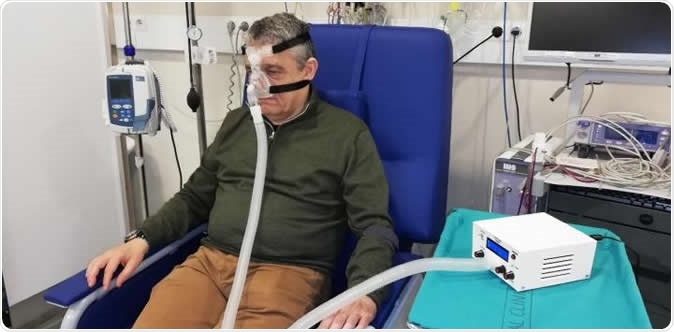The demand for ventilators has dramatically increased over the past months, due to the coronavirus disease (COVID-19) pandemic. With the increasing number of infected people across the globe, health systems have become overwhelmed, and equipment shortage is a huge problem. Further, health workers are at a high risk of contracting the virus due to invasive ventilators and the need to intubate and suction patients. Now, scientists have developed an easy-to-build, cost-effective, and non-invasive ventilator that works akin to commercial devices.
The researchers from the Ramon Farré, Professor of Physiology in the Unit of Biophysics and Bioengineering at the School of Medicine of the University of Barcelona, Spain, have developed an affordable ventilator that aims to support the breathing of patients with respiratory failure.
The study, published in the European Respiratory Journal, comes at a time when the shortage of ventilators has become a problem across nations affected by the novel coronavirus, now called severe acute respiratory syndrome coronavirus 2 (SARS-CoV-2). COVID-19 disease, caused by SARS-CoV-2, has overwhelmed hospitals due to the lack of intensive care unit beds and ventilators. Across the globe, more than 2.5 million people are infected, while more than 177,000 died due to the viral infection.
Non-invasive ventilator
One of the essential features of the newly-built ventilator is that it is non-invasive, which means there is no need to insert any tube into the patient’s airway. This way, the ventilator can still assist the breathing of the patient, without the risk of infecting the healthcare workers, and at the same time, reduce the risk of further infection due to the inserted tube.

Low-cost, easy to build prototype ventilator during use. The ventilator can be used to support COVID-19 treatment in low income regions of where ventilator supplies are limited. Photos courtesy of Prof. Ramon Farré.
Non-invasive ventilation is delivered using facemasks or nasal masks, which push pressurized air into the lungs. The method supports the natural breathing process, enabling the body to fight the infection and recover faster.
In the paper, the researchers show the device, which is free to replicate, and how it can be built using easy-to-find materials. The team said the prototype ventilator could help fill in the need for more ventilators as the number of coronavirus cases has increased over the recent weeks. Also, the ventilator can be used in other severe respiratory diseases in low-income regions where there is a shortage of ventilator supply.
“In light of the ongoing coronavirus pandemic and the escalating need for respiratory support devices around the world, we designed a ventilator that can be built at a low cost using off-the-shelf components. The ventilator is intended to support hospitals and health systems that are struggling to meet the demand for ventilatory support due to coronavirus and other severe lung diseases,” Ramon Farre, a Professor of Physiology in the Unit of Biophysics and Bioengineering at the School of Medicine of the University of Barcelona, explained.
Low-cost
The ventilator is affordable and low-cost, amounting to just about $75. The ventilator has a small high-pressure blower, a controller with a digital display, and two pressure transducers.
The team tested the efficacy of the ventilator prototype compared to a commercial ventilator device. The team used the device in 12 healthy participants, whose breathing was partially impeded by letting them wear bands around the chest area, similar to obstruction in the upper respiratory tract. The band will provide similar levels of chest tightness and shortness of breath.
The participants wore face masks, which are fitted over the nose, to help in breathing. During the experiment, the participants plotted and scored their level of comfort or discomfort. The team studied and observed the participants during the test and found that the ventilator worked effectively in providing breathing relief, which is the same as the one reported using a commercial ventilator.
The researchers also performed bench testing, a method where lung modeling is utilized to determine how well the ventilator provides oxygenation and supports breathing in patients. There were 16 simulated conditions, which is similar to real-life situations, and the prototype has worked efficiently in supporting the lungs in working correctly across all simulations.
“Our tests showed that the prototype would perform similarly to a conventional, high-quality device when providing breathing support for patients who, although with great difficulty, can try to breathe by themselves. This low-cost device could be used to treat patients if commercial devices are not available, and it provides clinicians with a therapeutic tool for treating patients who otherwise would remain untreated,” Professor Farre added.
The non-invasive ventilator shows promise in providing breathing support to patients with respiratory failure, which is one of the complications of the current global pandemic, COVID-19.